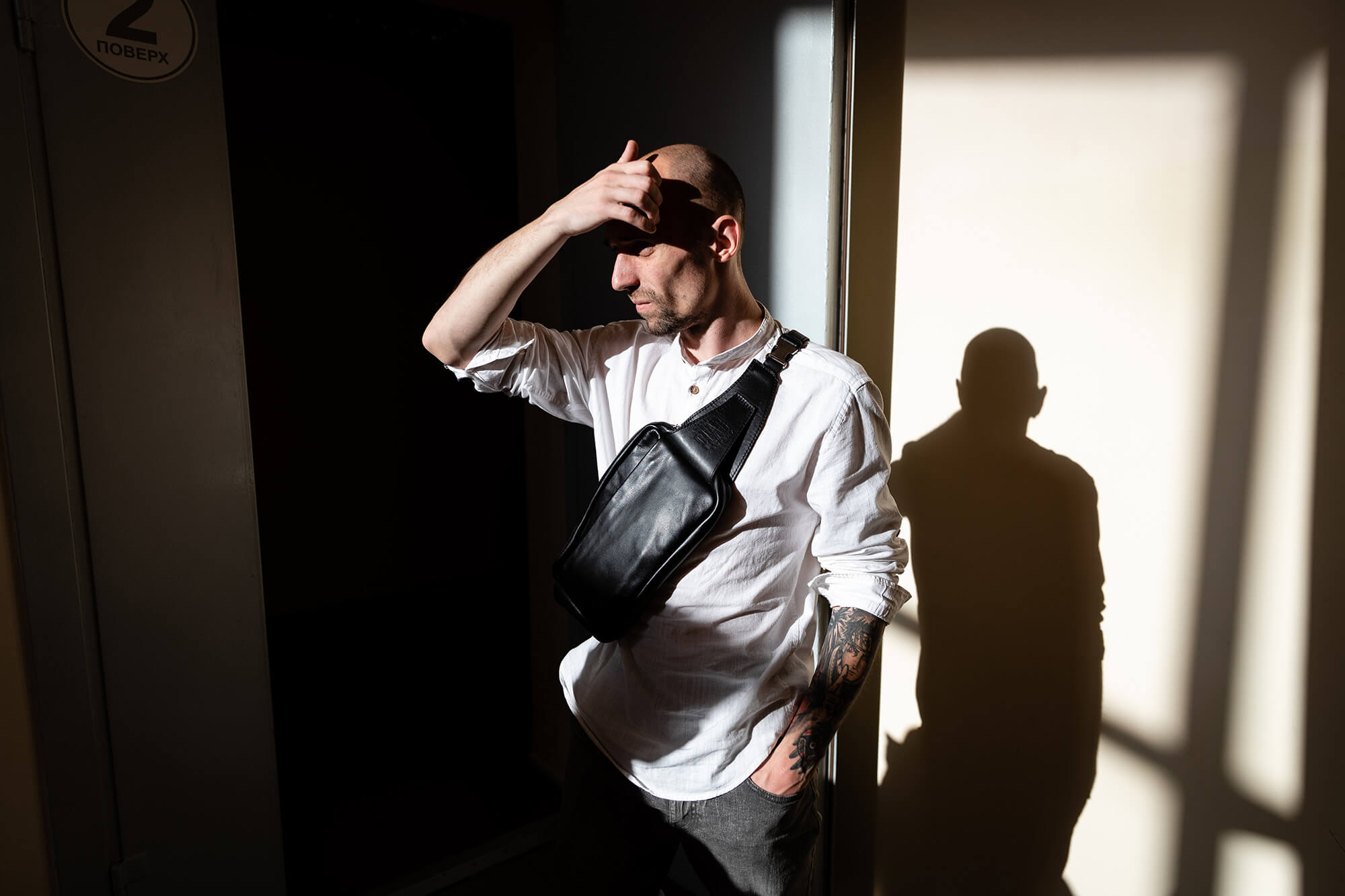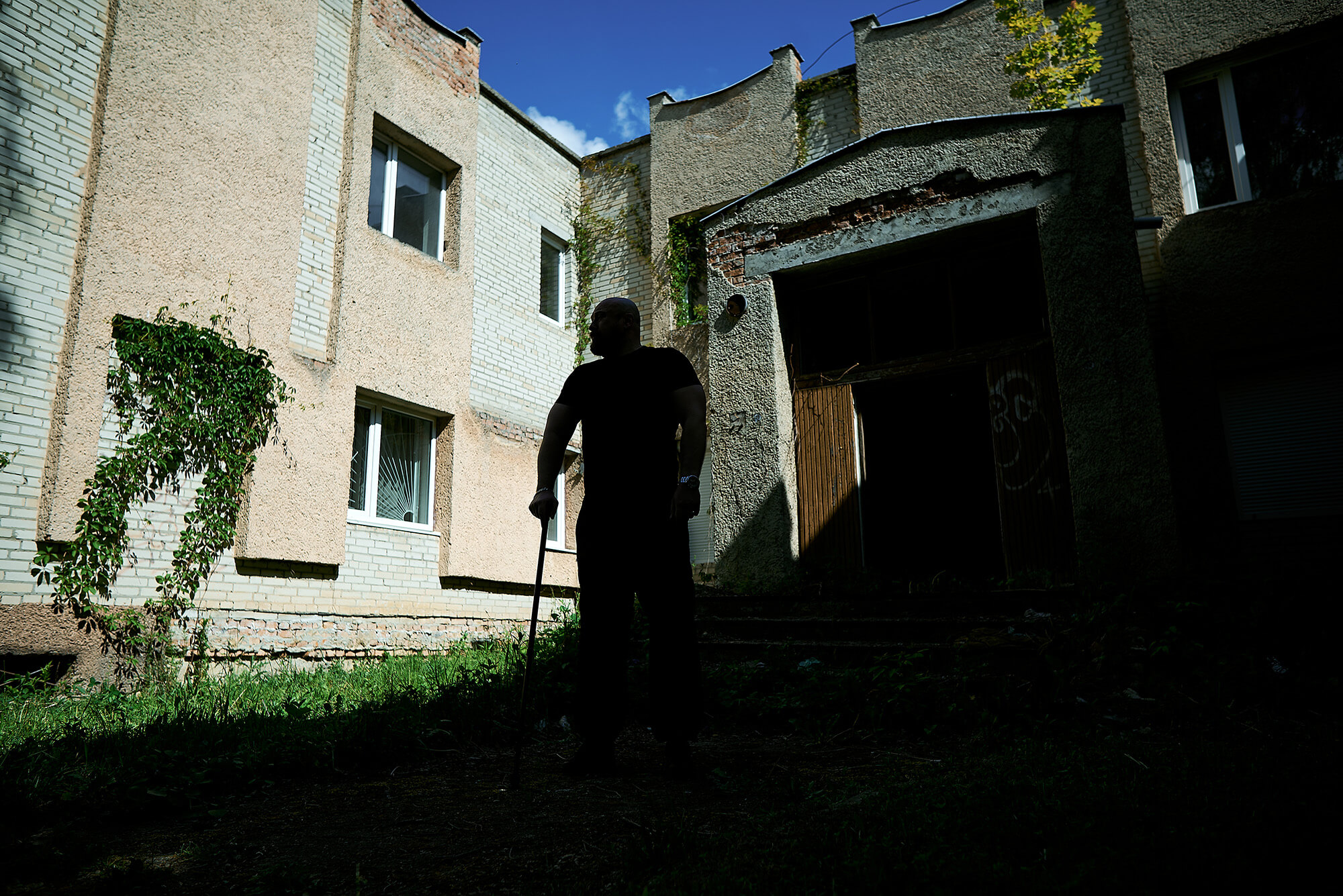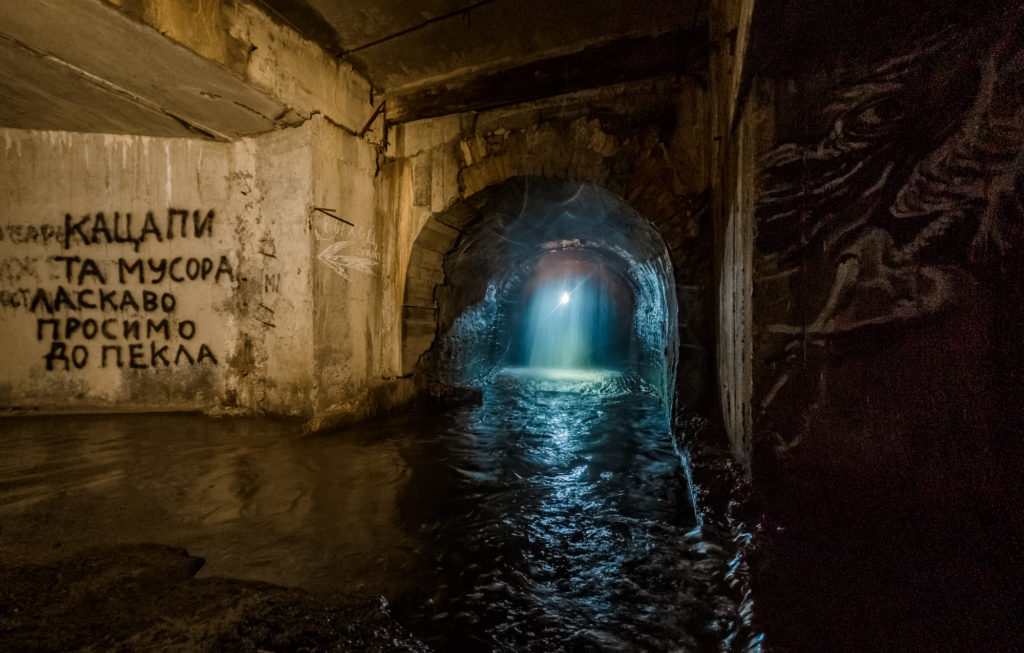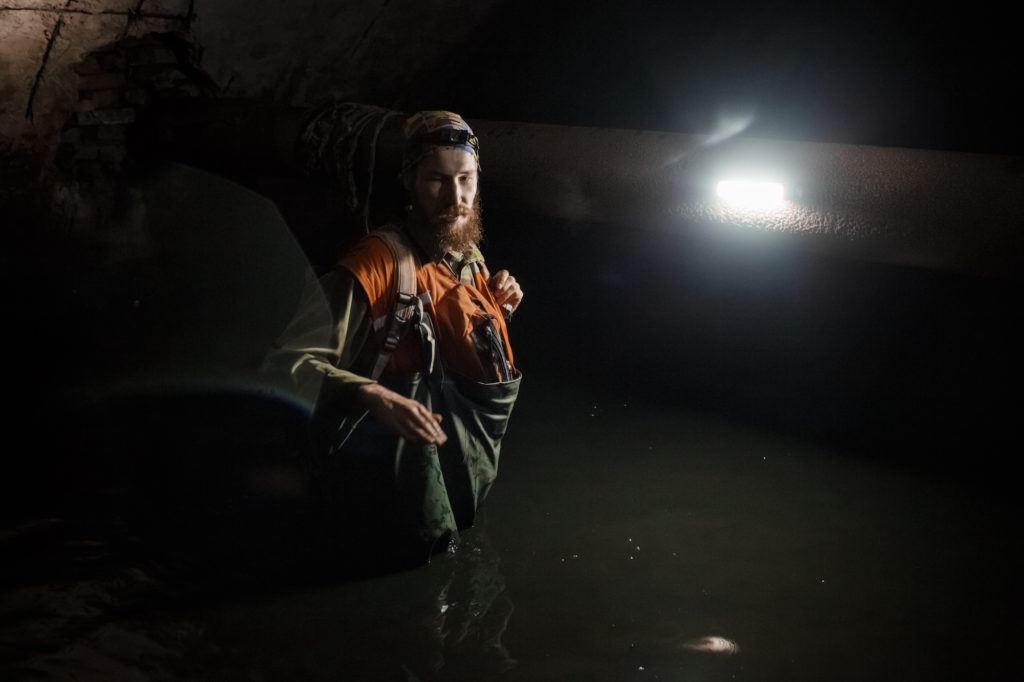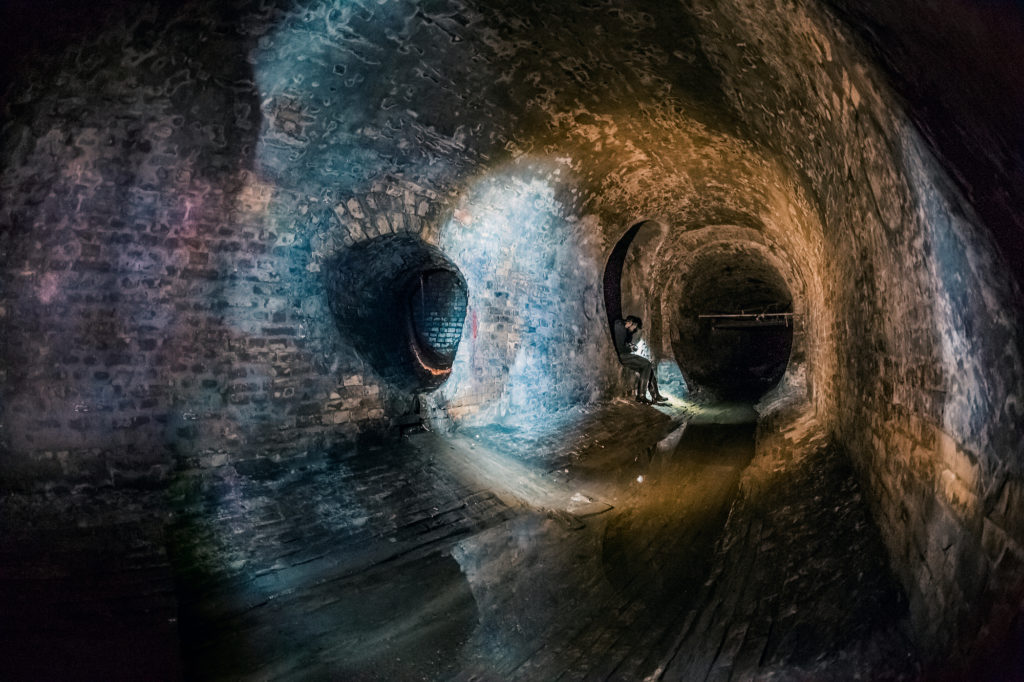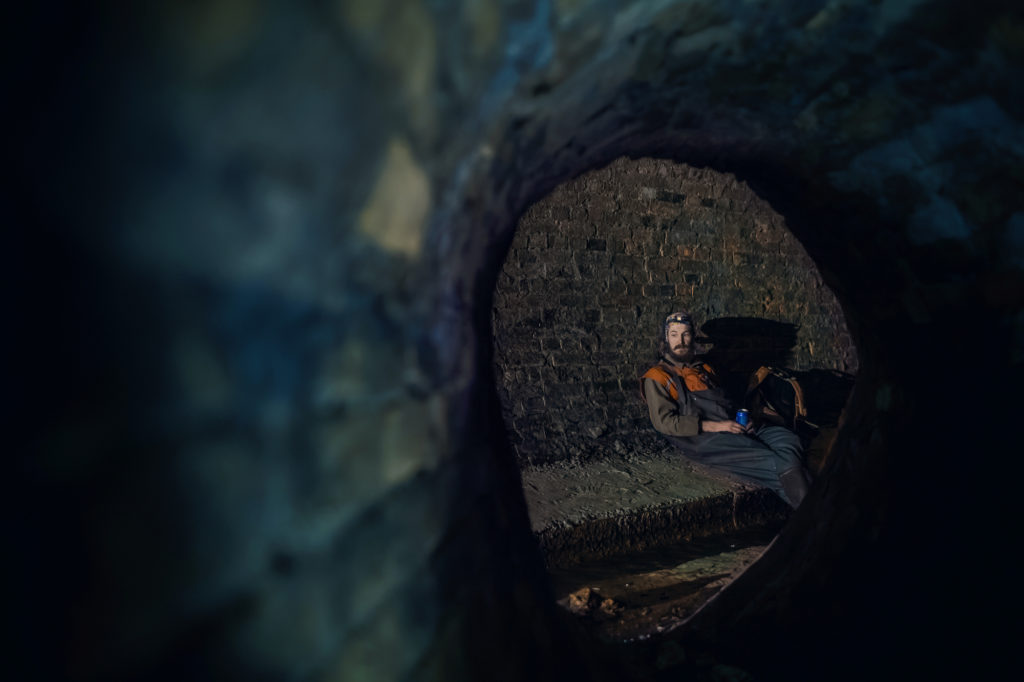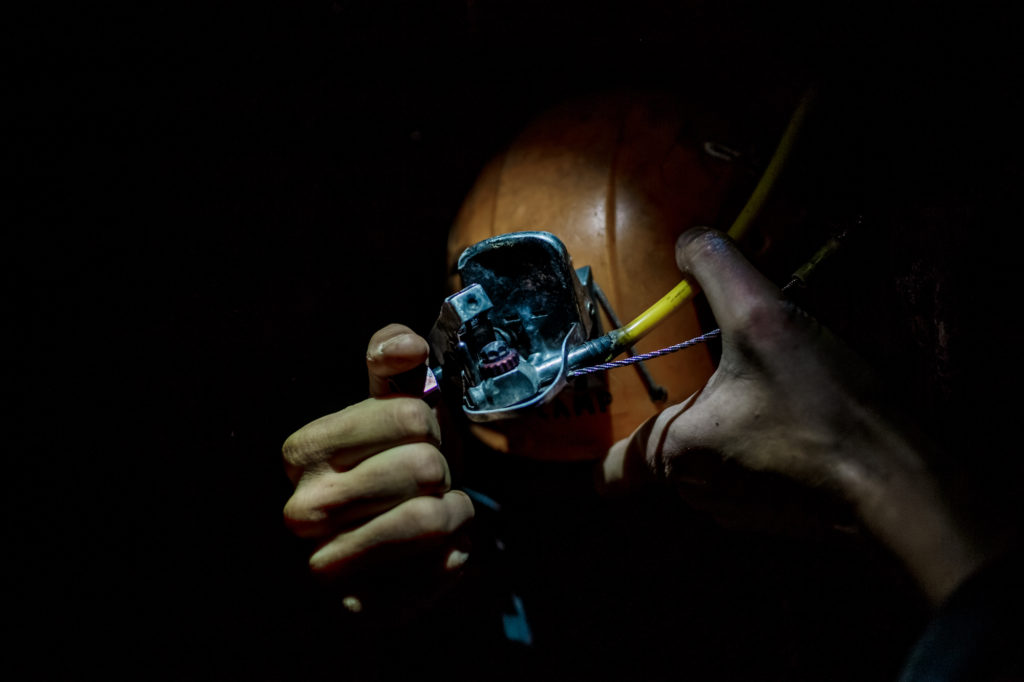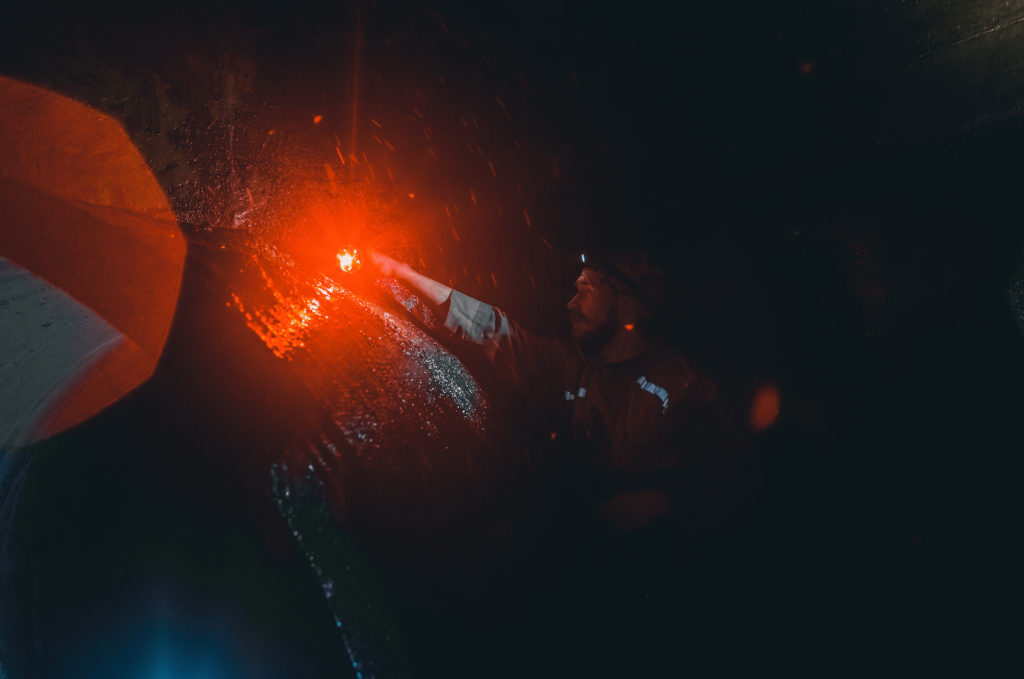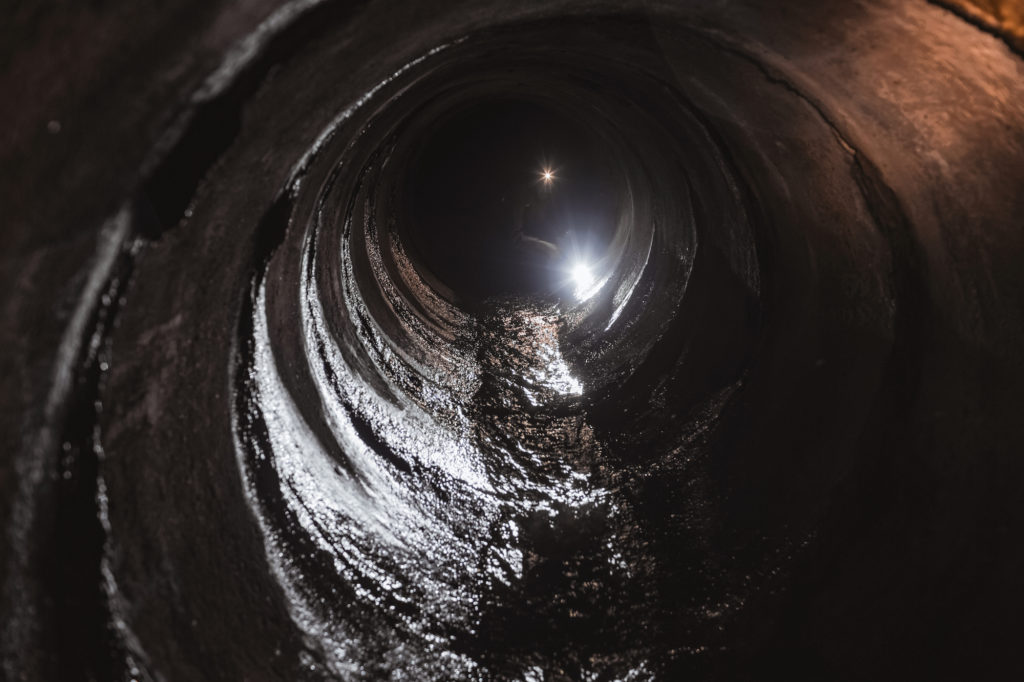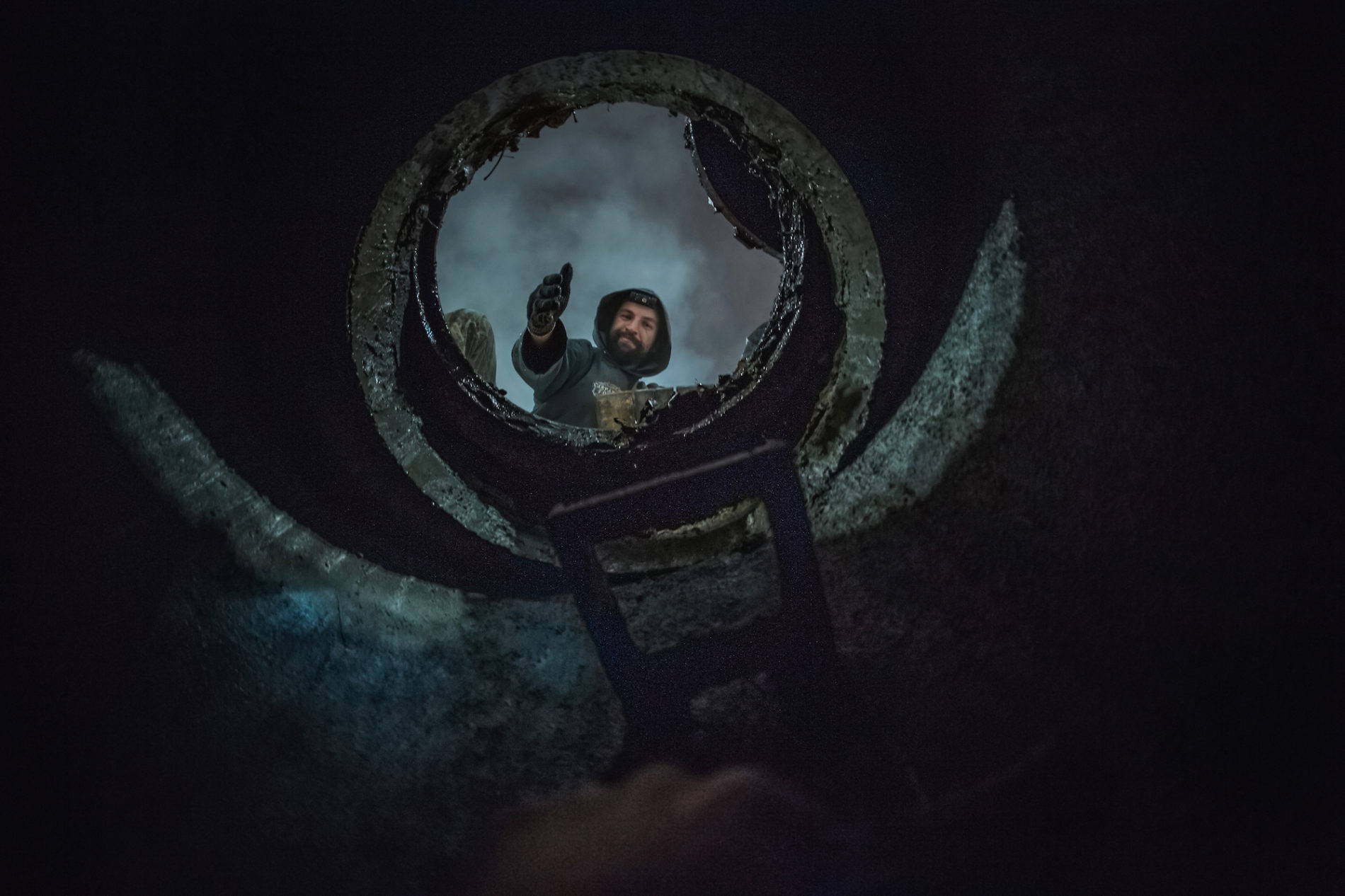
Keepers of the Underground
Over 80 kilometers of tunnels with underground rivers, 34 kilometers of drainage systems that support the slopes of the Dnipro, and 80 kilometers of the metro. Plus the extremely long, cunningly intertwined sewers and many other secret places. People who get a thrill from wandering there are called “diggers.” A year ago, the longtime participants of this movement founded a community organization insisting on their new role as researchers. We go underground with them to find out why they took this step.
In June 2008, there was unrest in Kyiv. The city was getting ready for its largest ever open-air concert—the performance of a music legend, one of the founders of the Beatles, Sir Paul McCartney. The sky above the capital thundered and filled the streets with rain.
The weather was so bad that the water broke a dyke and ended up in the excavation pit of the Holosiïv metro station still under construction. The elements had entered the transportation tunnel.
Dmytro was just then returning home when panic broke out on the digger forum — four people had gone into the Klov! That’s the name of the stream that is completely hidden in a sewer, the traditional place Kyiv’s diggers congregate.
The stream flows into the Lybid River; when that overflows, swelling out of the concrete canal beyond the city limits, it spectacularly floods its banks and uproots trees. The diggers had stationed themselves not far away; they wanted to see how the water would burst forth from the sewer and gush into the Lybid.
“We’ll have time to turn around,” four of them casually said to the crowd and entered the sewer. As they entered, they were greeted by a memorial plaque to two boys who died there in 2003 that was nailed to the interior wall.
Almost no one would manage to save them. The tunnel has an irregular form so that when the water is at knee-level, it can reach waist-level two meters on. A pipe sticks out across from your eyes—it’s a sewer line. In the case of rain, and especially a storm, it is nearly impossible to swim out—the stream gets stronger and fuller and can knock you off your feet in a few minutes. Then it slams you against the ceiling, the fittings, or simply carries you along.
That time, in June 2008, two people managed to grab ahold of manholes and crawl out; the other two were swept away into the Lybid before the very eyes of those still on the street. The girl’s body has not yet been found.
After this episode, no one else would drown.
Experienced diggers know what it is important to consider before risking going underground. There is an entire complex of rules as well as a particular underground ethics among the pros. Yet over the years, the younger diggers have begun to form groups on social networks and skip the training of their experienced “colleagues.” After the 2008 tragedy, they marked the most popular underground places indicating where you could escape through a hatch just in case.
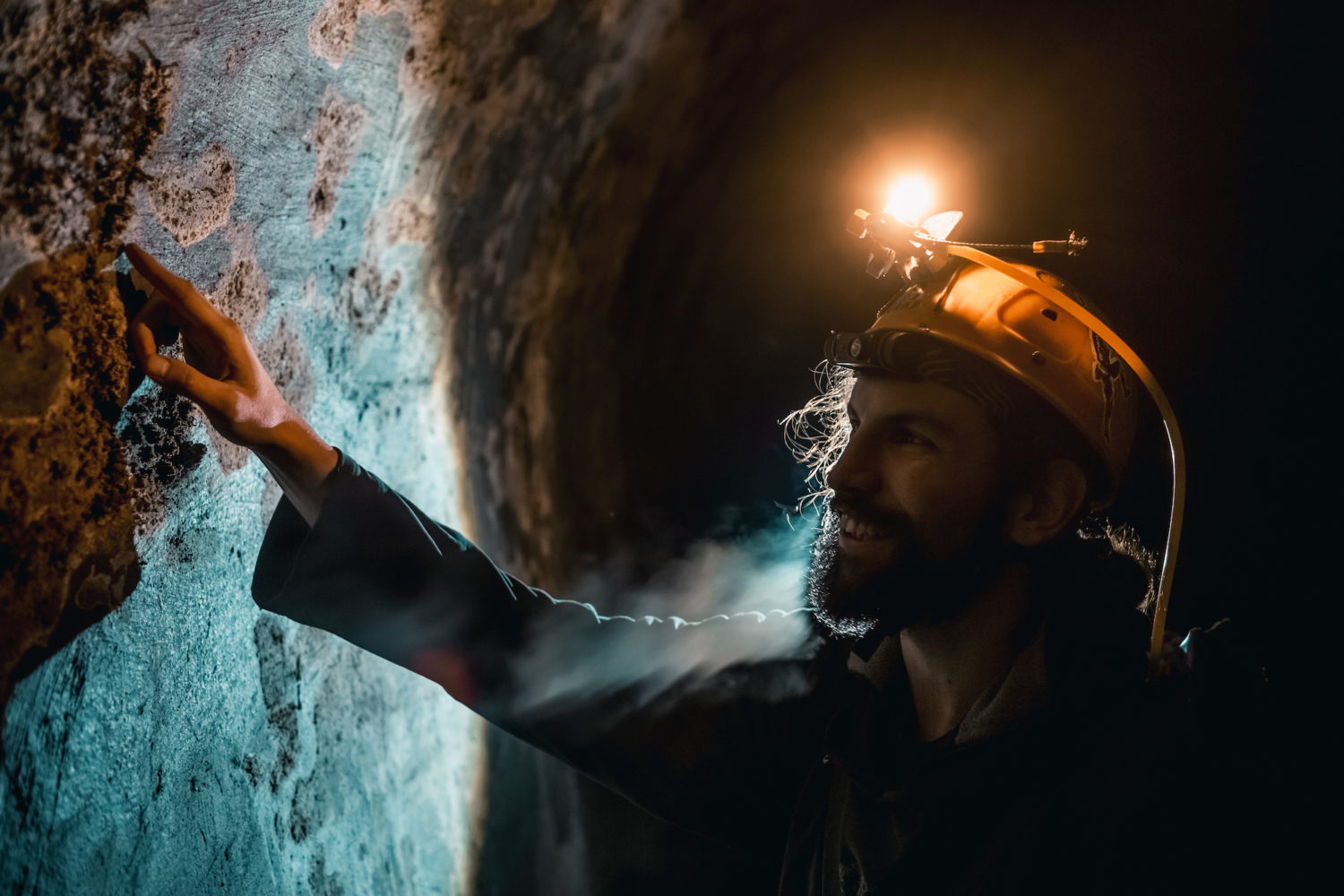
But carelessness is not just flirting with the elements. The most ardent youths can also wreak havoc: crawling along moving Metro trains, planning underground parties complete with fireworks, breaking locks, or harming machinery — this can lead certain offices to bring them to justice.
In 12 years of rambling underground, Dmytro, or as his friends call him, “Devover,” has seen a lot. In order to preserve what remained of the conscientious digger community, he and ten other guys decided to found a community organization, the Kyiv Spelestology Association (a portmanteau of speleology, “the study of caves,” and the German Stollen, or “tunnel” — the study of human-made underground structures).
“We arrived at a single idea — to preserve the diggers’ good name,” Dmytro explains. “To become not only diggers, but spelestologists, or scientists. To study everything that surrounds us underground.”
Careful, Falling Butts
“You see, I even have an ID,” a tall, bearded youth offers proof of his membership in the organization. Among his friends, he’s known as Feodosii Pechersky in honor of St. Theodosius of the Caves whose body is preserved by the monks at the Lavra cave monastery in Kyiv.
We’re standing at the entrance to the Klov sewer. It does not stink, but it’s noisy: up above cars are constantly driving over the manhole covers and the echoes of the clangor roll underground.
Ahead, there is a pipe across the tunnel; various ribbons and the long banners of colorful plastic bags hang out of it. Digger sentimentality perhaps?
“Nah, that’s just some trash!” Feodosii laughs.
The guys often have to clean it up, but not always for ecological reasons: “When you’re crawling around the pipes,” the digger says, “you clear away the trash because otherwise you won’t be able to get through in 2–3 years.”
But in an underground river, like here in the Klov, there should not be any trash at all. Ukraine primarily has a separated sewer system: the river flows in one tunnel and household wastewater in another, unlike in Europe where everything flows together. If there are no strong storms that force emergency overflows, then after treatment, the water enters the channel of an open body of water.
Ukrainians don’t appreciate the advantages of their drainage system. For example, they open car washes and rinse the soap off into the underground river. “We can see when sewage ends up in the river and we report these instances to the responsible offices,” Devover says.
There is another particularity of underground Europe — for the convenience of utilities, they have underground street signs. Ukrainian diggers, on the other hand, need no signs: they know everything like the back of their hand.
“This is the bus stop in front of the Pechersk court. You can take a look,” Feodosii indicates a long cavity in the wall — just be careful that a cigarette butt doesn’t land in your eye.”
The cavity ends in sewer grates. From there it is possible to see feet and hear cars. Nothing feel on my head — no trash even stuck to the walls.
But that’s far from what always happens. One of the reasons Kyiv flooded so badly last summer was precisely litter in the storm drains.
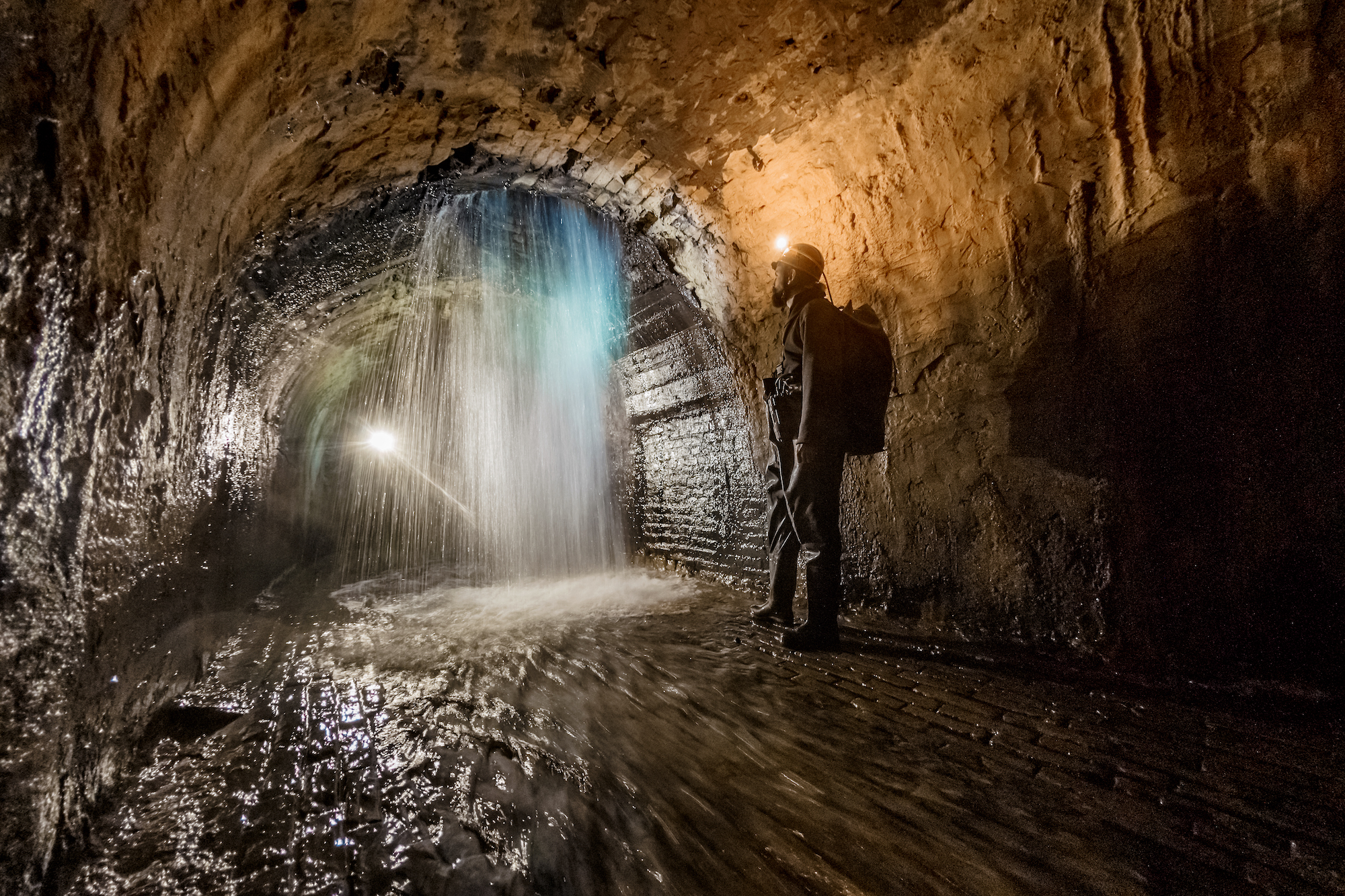
“It’s a classic story — the polyethylene bag,” Devover explains. “You see, it gets washed away, carried into the basin of the storm sewer, and from there it goes into the pipes. And if the bag gets stuck there, the throughput gets many times worse. There’s a ton of stories about how in Podil the water burst up through the manhole simply because the pipe beneath was blocked.”
This was how memes appeared with Klychko swimming up from a flooded underground passageway. The less creative, yet more aware citizen calls the mayor’s office or other offices with complaints.
Underground Volunteers
“Who are these diggers? What did you do there?” was how the guys were answered by the various offices on the other end of the line, refusing to react to the emergency.
Usually citizens themselves don’t understand who it is best to turn to. “The utilities are more understandable — tons of crazies call them up,” Feodosii explains. “Or if a road is out, it’s ‘call the mayor’s receptionist.’ It’s like, ‘Come on, Klychko, fix the road.’ Of course this doesn’t work.”
If there is an accident you can write to the contact center or call number 1551, which is staffed by the mayor’s call center. But operators can get confused and send the claim to the wrong service. For example, a sewer near a factory fails, so the factory is responsible for the repair. Instead the claim can arrive at the Kyiv DOT or the Pleso municipal enterprise, which maintains a portion of the sewers. After a few days the claim returns marked “not ours” and it begins to wander in search of its owner. Or it simply falls by the wayside.
“We’re somewhere in the middle. On the one hand, we understand where to direct the claims; on the other, the majority of the offices already know us and they trust us more,” says Feodosii.
The diggers insist that nobody fixes what isn’t broken. They were forced to become a community organization. “You think, an ID, huh, but we’re no better or worse off with this,” he explains. “Our pace and type of work haven’t changed, but a few office have refused to cooperate with individuals.”
This started with a certain persistent individual. Having secured legal aid, the digger Mykhailo Storozhuk started writing to and bothering a variety of offices. Ultimately the sides reached an agreement: the water management bargained with the guy that he would inform them of accidents where there were leaks.
This lasted for years. And when the diggers became a legal entity, the water management already understood knew the score.
They don’t get paid for their work. “But we get other pluses,” Feodosii explains. The water management organizes tours of their facilities for us.”
Following Stotozhuk’s example, the diggers also had an annual agreement with Kyiv Energy. For this they were paid: according to the contract, a certain person got up to 5000 hryvnias every month. “This was more methodical work,” says Feodosii. “When we found evidence of an accident, we would cross into the Kyiv Energy network and look there.”
Today this digger can identify the place of the accident by the scent of the water. For example, water from the water management smells like chlorine from a pool. River water smells like rotten leaves and the street. If it’s coming from insulated pipes, it smells like dust and impurities.
Diggers cooperate with organizations in various districts of the capital. They have other work, too. For example, they compiled a map of sewers for the Solomianka district — an ordinary task for diggers — because the state maps turned out to be out of date and poorly done.
“There’s nothing strange about this,” Feodosii shrugs his shoulders. “This is an ecosystem in which we are guests, but we’re there more often than everyone else. You could say we’re underground volunteers. Even though in general we have a choice: not all diggers notice accidents. But for us it has become a habit.”
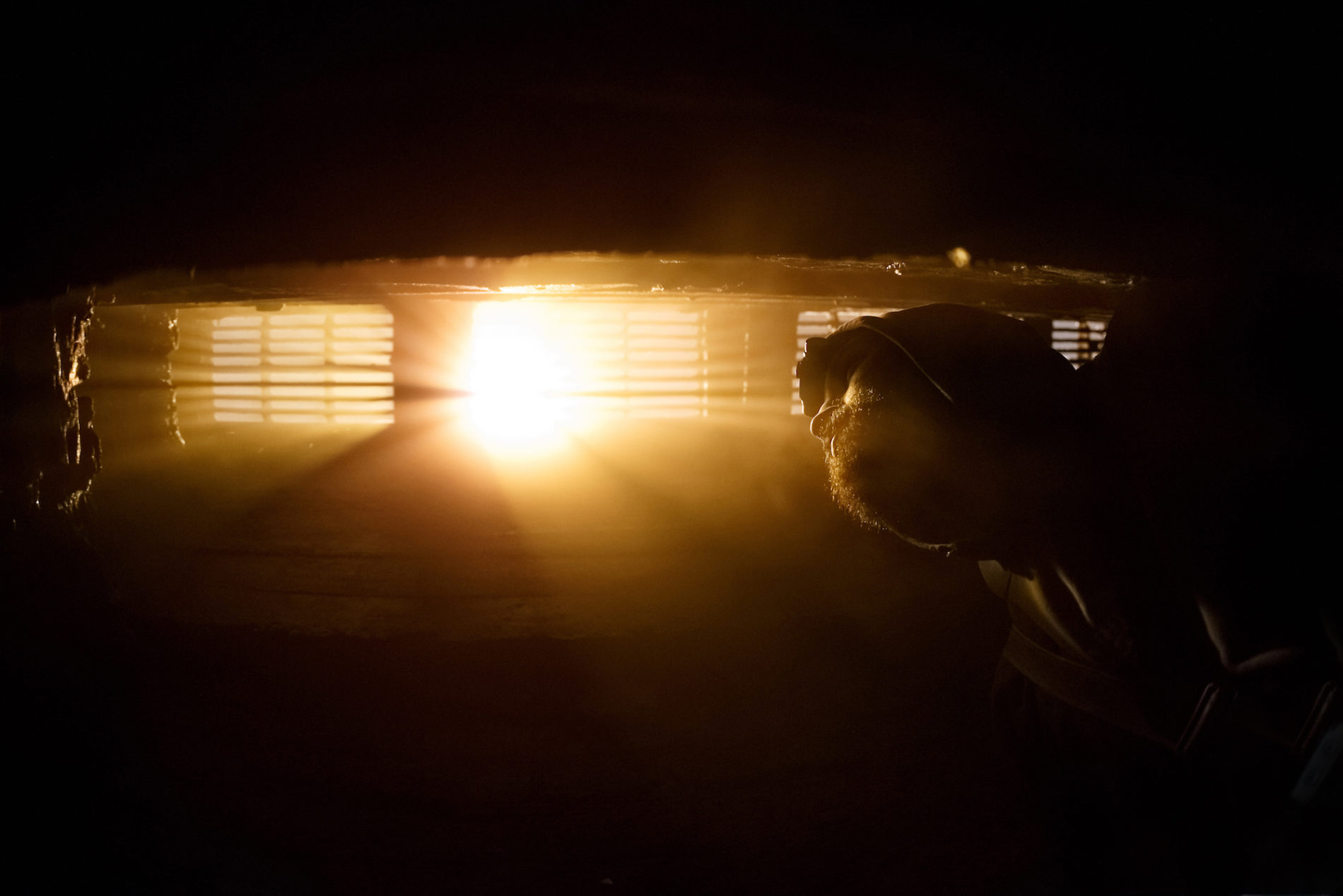
The last large-scale accident happened last summer in the Hlybochytsia River that flows under Lower and Upper Val Streets. After a storm, a sewer there was pretty much washed away. A vault collapsed and large pieces of it were floating in the water, which in some places was greater than waist high. The diggers shot a piece on this with journalists and were climbing out of the manhole right when the chief engineer of the Podil district showed up. Initially he shouted at them for a long time, but then he agreed it was better to collaborate. The diggers were even invited to a field meeting. At that moment, they also found a contractor that was supposed to undertake reconstruction.
“The boss, perhaps he wasn’t pleased that we were crawling around, but he didn’t have his own people,” Feodosii explains. “It’s easy with us: we find the accident, tell you about it, and according to the contract, sometimes even do repairs when something is minor.”
The diggers still love it and they understand that they are mostly doing other people’s work. But the utilities have a limited workforce: “The underground utilities in the Pechersk district only employ two monitors. There are practically no new faces. And those two don’t have enough time or enough equipment to conduct inspections, especially in the pipes less than a meter in diameter.”
Devover believes that everything comes down to money: “What young, able-bodied guy will go to work as a plumber for 8 thousand?” The diggers themselves earn their livings in other ways: Dmytro is a mechanical engineer; Feodosii’s in IT.

This is one half of the problem, but the main issue is management. “As long as this sphere is under the state and all these offices are occupied by Homo sovieticus, people will simply not be motivated to execute their work competently. For this reason, apartments and courtyards are heated around the clock and the pipes are constantly breaking,” Devover explains. “Of course this is a subsidized sphere, but it could be made to lose less money.”
Indiana Jones
There’s another direction of work—historical. When the guys find some ancient grates, bricks, or what have you, they give them to the Museum of Water. They cannot be called treasure hunters — other people search for lost telephones and gold chains here, but history is important to the guys.
In order to find new places or something truly exciting, Feodosii studies the archives. The first mechanized aqueduct — one of the oldest in Europe — was a brilliant find. The diggers conjectured that the pipe itself was the aqueduct. In order to prove its function and location, they had to sort through a bunch of old blueprints and even ordered an engineering journal from the library in Khabarovsk, Russia. Two years later, Feodosii was able to confidently state they had found the aqueduct.
“There’s probably no use in it. But sometimes I feel like Indiana Jones,” Feodosii laughs.
He suddenly grows worried. There is construction happening on the territory of the Arsenal right where this old aqueduct passes. “Most likely it will come down to quietly carrying that first pipe away from there,” he says. “Who if not us?”
A Museum under Their Feet
“That’s it, we’re here. Khreshchatyk,” Feodosii points to the vaulting beyond which there’s no visible way out. “This is the underground passageway, just from the other side. Farther on the tunnel only gets smaller.”
The digger tosses his backpack on the ground, takes out a Pepsi, and drinks sweetly from the can, leaning against the brick wall.
Hanging out underground is ordinary. Feodosii held his bachelor party there and recently a digger’s work party. Generally the guys get together once a month underground to grill and reminisce. They drink tea since they’re “too old” for alcohol.
“At one time it was a big deal, but now we’re all around 30,” Feodosii gets serious. “What you’re looking at now, this is 5% underground and the other 95% is pipes. You think when you crawl kilometer after kilometer over the years, it’s good for your muscles? You can feel that they’re not what they used to be.”
We turn back through the pounding waterfall — if you don’t slip through fast, your face can get drenched. Through the Star Gallery — a small portion of a sewer where hundreds of shiny drops of condensation gather on the ceiling, truly looking like a starry sky under the light of a headlamp.
We didn’t come across any rats. Or bats either — they’re more in the drainage systems, which the underground ethics prohibit visiting in winter. “This would be certain death for this endangered species,” Devover explains. “You wake them from hibernation and they don’t have insects or any other food.”
Sometimes chestnuts fall into the drainage system and start growing, but not with trunks and leaves like on the outside, but like grapes — underground they begin to curl.On the Kyiv Spelestology Association page, the guys regularly post reports, stories, and photos of their expeditions. But they do it in such a way that no one could guess how to get there. “All the information is worth its weight in gold. This is the kind of work where there are always rivals,” Devover explains. “Because if we’re going somewhere, there must be something interesting there. It’s like a nice clearing in the woods: birches, pines, grass. And later everyone finds out about it, they come in their cars, they litter, and that’s the end of that.”
The same rule apply abroad. Foreigners, thirsty to see the Ukrainian underground, identify the responsible diggers from photos that don’t give away their location. “Later we write to each other or cross paths and exchange our experience. We go to them to crawl around and they come to us. People often come from Europe, America, and Canada,” says Devover.
A few of the pros organize underground tours. If you shine your flashlight at your feet when the Klov is at high tide, you can see hundreds of distinct tracks: until bacterial colonies grow on them anew, they aren’t washed off. This demand somewhat irritates the diggers, but also plays into their hand a little.
The guys want the sewers to be recognized as monuments — no different from buildings with memorial plaques. Then they won’t be ruined, forgotten, or filled in with concrete in order not to service them. Today this threatens an old sewer in Podil. According to some sources, the architect Volodymyr Nikolaiev, the same one who built the Church of the Intercession, a few buildings at the Kyiv Pechersk Lavra, and many other old monuments, was involved in its construction.
“It’s no less an engineering school than what we have on the surface,” explains Feodosii. “We want to preserve the example of what our ancestors built.”
The diggers have found solidarity in this idea, so everyone who leads tours into the underground world, collects signatures to turn it into a museum. A few sewers have long had a case for monument status; a few others underground structures are protected by the state as part of the Lavra complex. The digger is convinced: if he and the others knock on every door and ring every bell, they will succeed in seeing their project to the end.
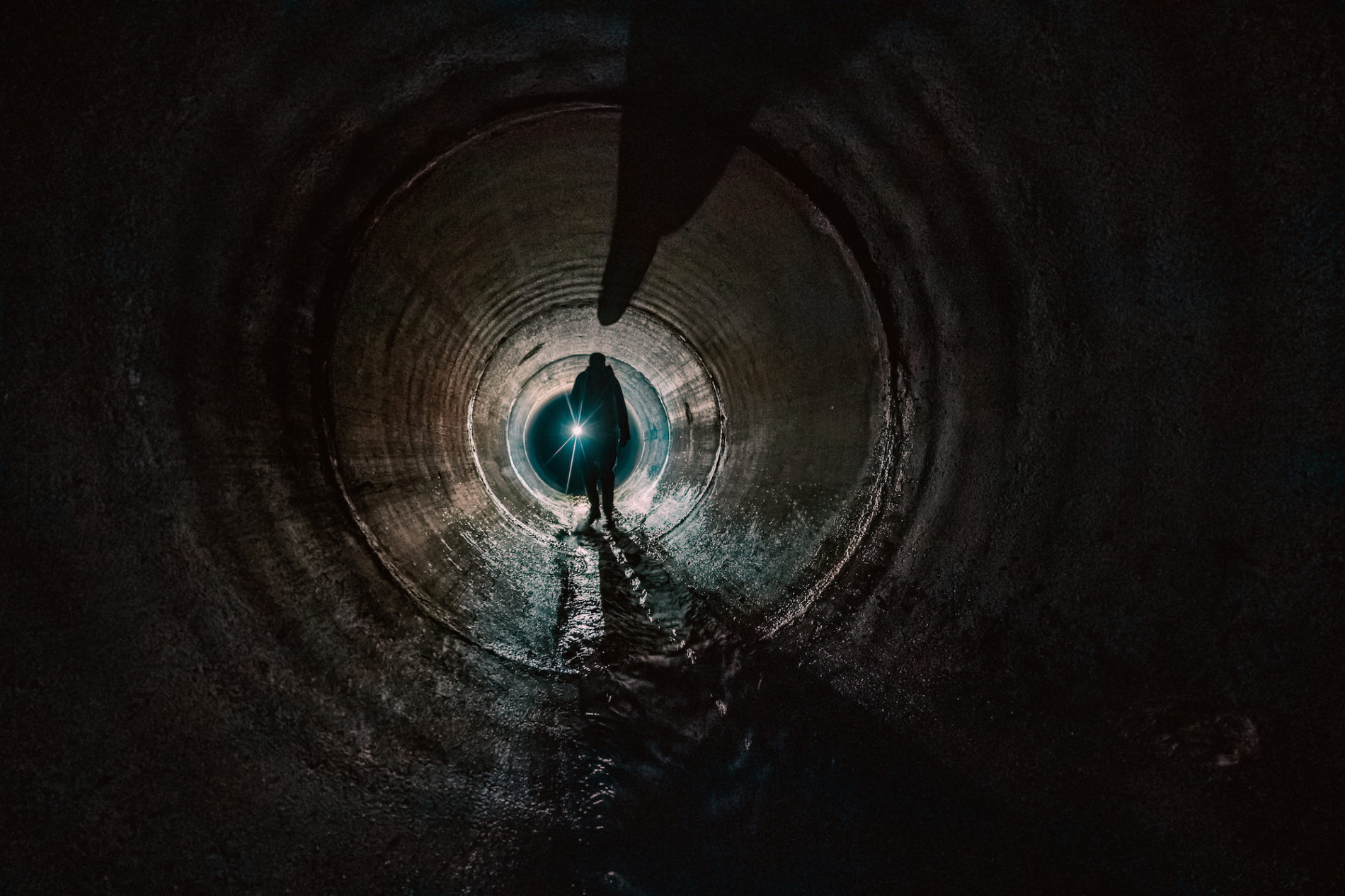
Translated by Ali Kinsella.
Have read to the end! What's next?
Next is a small request.
Building media in Ukraine is not an easy task. It requires special experience, knowledge and special resources. Literary reportage is also one of the most expensive genres of journalism. That's why we need your support.
We have no investors or "friendly politicians" - we’ve always been independent. The only dependence we would like to have is dependence on educated and caring readers. We invite you to support us on Patreon, so we could create more valuable things with your help.
Reports130
More